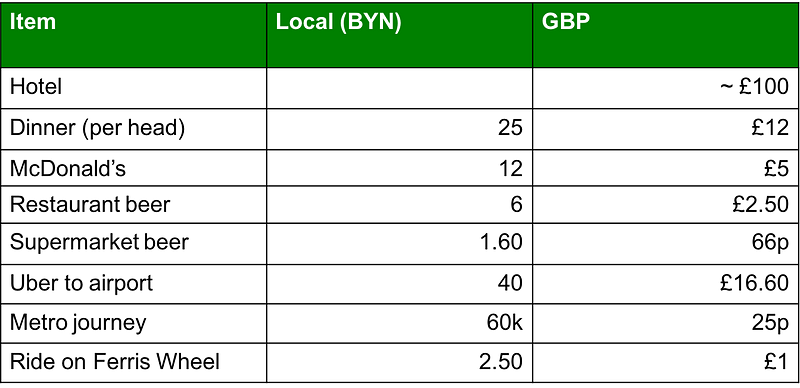Travel Guide to Minsk

I visited Minsk expecting a Soviet time machine.
I thought it would be like Moscow was in 1992.
But I was wrong.
Yes, it’s architecture and visible insignia reflect the fact that most of the city was completely rebuilt straight after the second world war. Military uniform is everywhere, tractors roam the streets, school children look immaculate. And the absence of a democratic transition casts an intriguing shadow of communist rule. But the city is vibrant, affluent, and spotlessly clean. It feels more like a Baltic city break than an Eastern European industrial wasteland.
Outside of Minsk there’s an efficient train network and the surrounding countryside is beautiful and famously peaceful. I strongly recommend a visit to Belarus, and hope these notes are useful.
Flights
Belarus has connections to most major European cities. The national airline, BELAVIA, do a direct flight from London Gatwick to Minsk several times per week. If you want to travel by train, there’s only one man to ask.
Arrival at Minsk airport
-
- A recent policy change means that a visa is no longer necessary for trips of less than 5 days from a number of countries.
- Customs officials will ask to see proof of Travel Insurance (and they may also request to see an associated membership card).
Accommodation
-
- Using a travel agent used to be a necessity because they could provide a letter of invitation (which was mandatory to obtain a visa). I used MinskLuxx who have an array of city-centre apartments and helpful services.
- Centrally located chain hotels include: Crowne Plaza and DoubleTree by Hilton.
Getting around
-
- Taxis to/from the airport cost ~ €20. Licensed taxis have yellow plates and can be trusted, and Uber is also available. There’s also a bus service to the train station.
- Trains are cheap and easy to use.
- The Metro is simple to use and has a regular service. Each journey requires 1 token (60 Kopeks) which can be bought at the ticket office.
Things to see
Minsk itself is easy to explore on foot. I recommend the following:
Day 1:
-
- City gates (outside the train station)
-
- Independence square (and the shopping centre underneath)
-
- GUM shopping centre
-
- Victory Square
- Gorky Park
Day 2:
-
- Great Patriotic War Museum
-
- Botanic Gardens
- National Library
For more: http://www.belarus.by/en/travel/belarus-life/minsk-attractions and https://34travel.me/gotobelarus/en/post/minsk-english-guide.
Restaurants
There are clusters of cafes and restaurants in the following places:
- The upper town (vulica Zybickaja) – this is the main tourist area and contains several bars and restaurants on the banks of the river. 442 is the best place to watch soccer and sample interesting beer. Cherdok do great burgers in a laid back setting. Malt & Hops have a long and classy bar serving beer and many malts. El Pushka is a fun and intimate tequila bar. Beer Cap is a classic Eastern European-style bar – an outdoor labyrinth with interesting beers and a range of customers.
- Trajeckaja nabiarežnaja (the old town) – the only real area of pre-WW2 buildings, it has a nostalgic feel compared to the rest of the city.
- Karl Marx street – a number of classy bistros and restaurants with sincere cooking.
- Kastrycnickaja Street – former industrial units now famous for bright murals and hipster coffee.
For a distinctly Belarusian experience, Rakovsky Brovar is a large, popular brewery serving traditional food in a friendly atmosphere. And watching the world pass by at the bar at Centralny is one of Minks’s cultural highlights.
Typical prices (as of 2017)

Minsk provides a fascinating mixture of standard European ambience and a gripping historical context. Belarus is not quite Poland and not quite Russia – it is something else. Something tangible and settled. But forward looking and optimistic. It’s truly unique.
—
Also check out Joe Jenkins’ “Postcard from . . . Minsk” Financial Times, April 21 2017
Update: my Travel Guide to Minsk was featured by Belarus Digest